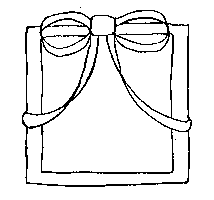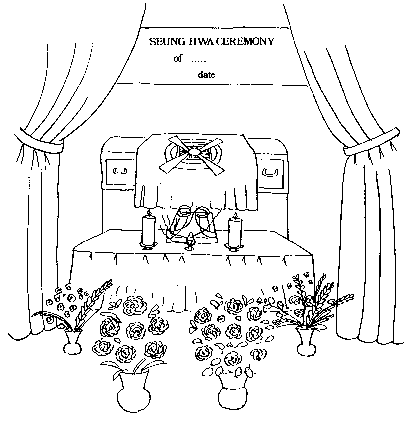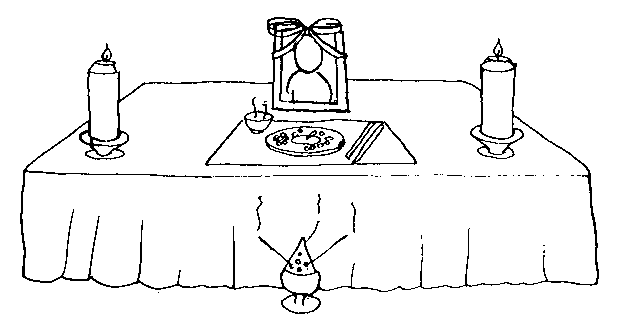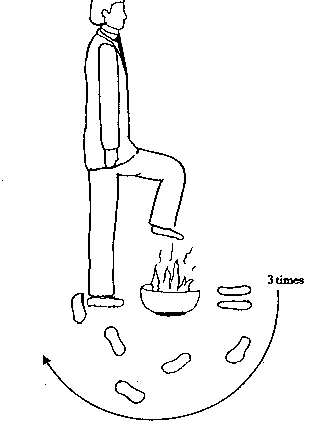
According to the Principle, death is the time when both the spiritual and physical bodies return to their original source. The spiritual body goes to the world of the spirit. We can say that the physical body returns to the material world through its eventual decomposition. The practice of cremation is not in accordance with the Unification view, as it does not allow the physical body a natural return to the physical (material) world.
The Principle shows us that Heavenly Father is involved in the creation of our lives, that His love is their main source. (Refer to chapter 19, Births, Birth Ceremony: Births, "Significance.") Until we reach perfection, in the truest sense, God owns our lives; we are only the stewards. After we reach perfection, He wants to bestow us the fullness of His love, creativity, and true life.
Our spiritual body grows through a reciprocal relationship with our physical body. Therefore, it is the Unification view that under the order of the universe, we should not willfully cut the connection existing between the body and spirit. Without the physical body, the spiritual body absolutely cannot grow.
When the question of euthanasia is raised in the case of an accident victim, it is our view that everything possible should be done to keep the body alive.
However, if it is known that severe brain damage is involved and there is absolutely no hope of recovery, we hold that it is not necessary to continue technological assistance to keep the body alive. Whether or not to unplug the life support system should be left to the discretion of the immediate family. If this is the decision reached, however, it is essential that death be allowed to occur naturally.
Members who become terminally ill and desire to prepare to go to the spiritual world should use the time they have left on the physical plane to reexamine themselves -- their relationship with God, True Parents, spouse, children, other members, etc. Such a time would be especially appropriate for deep repentance. Members may wish to study the Principle and Father's words and meditate on the essence of their lives as well. Rather than focus on fulfilling any external desires, members would do well to strengthen their relationships in order to prepare for their rebirth into the spiritual world.
The tradition of the Seung Hwa Ceremony for blessed members was taught by our True Parents after the death of their son, Heung Jin Moon, on January 2, 1984. World level Seung Hwa Ceremonies for Heung Jin were held both in Tarrytown, New York (Belvedere), and Seoul, Korea (the Little Angels School).
Even though many funeral ceremonies have been held for members of the Unification Church, it is only because of Heung Jin Nim's sacrifice for True Parents that the tradition of the Seung Hwa Ceremony could begin. Originally, this could not have been begun until the True Parents went to the spiritual world. Yet based on Heung Jin Nim's dedication and organization of the spiritual world, blessed members can now receive the foundation of the Seung Hwa Ceremony.
Until the initiation of the Seung Hwa Ceremony, funerals were held as ceremonies signifying the end of life. In the secular world funerals have often been viewed as sad occasions because people, due to the fall, have never fulfilled their true purpose from God.
The Seung Hwa Ceremony, however, is the celebration of the commencement of one's life as an exclusively spiritual being. According to the Principle, the Seung Hwa Ceremony is to be regarded as more beautiful, enlightening, and joyful than even the Blessing ceremony.
Father shared some thoughts about its significance on the occasion of Heung Jin Nim's Seung Hwa Ceremony at Belvedere on January 7, 1984. His comments were printed in the January-February 1984 issue of Today's World.
I'd like to make a very clear announcement that will set the tradition of our movement and our church. In the secular world, death signifies the end of life. However, in our world, death is like a rebirth or a new birth into another world. Particularly those who give their life for the purpose of the Kingdom of Heaven and for the sake of the movement are special heroes.
For that reason, we must not make those occasions gloomy or sad or feel discouraged. Instead we shall rejoice in the victory of the spirit in which that life was given for the mission.
If we here on earth become very mournful and gloomy it is like pulling the person who is going up to the heavens down to the ground This is a birth from the second universal mother's womb into another world, just like when a baby emerges from its first mother's womb.
A Seung Hwa Ceremony is actually comparable to a wedding, when men and women get married. It's not a sorrowful occasion at all. It's like an insect coming out of its cocoon, getting rid of a shackle and becoming a new body and a new existence, a new entity. That's exactly the same kind of process.
In our way of life and tradition, spirit world and physical world are one, and by our living up to that kind of ideal, we bring the two worlds together into one.
There are three basic phases to the Seung Hwa Ceremony. Although they are collectively referred to as the "Seung Hwa Ceremony," the farewell greetings which the immediate family (and trinity) shares with the elevated spirit are called the Gwi Hwan Ceremony (or "returning to joy"); the service held for the elevated spirit by family and friends is termed Seung Hwa Ceremony, (or "ascension and harmony"); the burial service is referred to as the Won Jeun Ceremony (or "returning home/to the palace").
Meaning of the Term Seung Hwa. The January-February 1984 issue of Today's World gave the following explanation:
The use of the Chinese character meaning "Seung Hwa" is new and unique to this ceremony and is not commonly used. The character for "seung" means "ascending, elevation." The character "hwa" has meanings of 'harmony and peace." The use of "seung hwa" was first instructed by Father at this time.
The basic Seung Hwa Ceremony presented in this chapter is the same for the husband or wife.
The casket as well as all garments should be sanctified with Holy Salt before the body is dressed and placed in it.
Blessed members will be buried in their white Holy Robes. The robe and white gloves, as well as newly purchased white underclothes, should be given to the mortician for dressing the body.
Items to be placed in the casket and buried with the body include: a Divine Principle book, a book of True Father's speeches, and the member's Holy Handkerchief. No picture of True Parents or the True Family should be placed in the casket. Other important personal items can also be put in the casket. The member's blessing ring should be left on. A Unification Church flag should be prepared for placement on the top of the casket.
True Father wrote words describing Heung Jin Nim's sacrifice on a cloth which was placed over his chest and buried with him. If the individual received such a benefit from True Father (the title "martyr," for example) such a banner may be made and placed either inside or outside the casket and buried with the body.
Depending upon the level of the Seung Hwa Ceremony it may be held at home, in a center, etc. For example, a national level Seung Hwa Ceremony would most naturally be held in the national headquarters building. A regional, state, or church level, etc., Seung Hwa Ceremony should be held in appropriate rooms within any of the centers or homes.
Farewell greetings by the immediate family, trinity members and close friends may be offered at home or in the memorial ("funeral") chapel. However, this largely depends on whether the member died at home or in the hospital, etc., and on the particular national laws governing whether or not a casket may be brought home.
Items relevant to this ceremony are described in the section, Preparation for Seung Hwa Ceremony. Placement of the casket and altar during this ceremony are described in the same section.
Generally, the casket is opened during this ceremony.
Those who attend may wish to place single flowers in the casket and bestow a farewell kiss on the cheek of the body.
The Seung Hwa Ceremony is our opportunity to offer farewell greetings to the elevated spirit. Our attitude should be one of sincerity and respect. As well, we should remember the efforts and dedication of his or her past life on the earth.
There is an appropriate dress code for members of the immediate family. Women should wear white or light-colored clothes. Men should wear dark blue suits with a white shirt and white tie.
Others who attend the ceremony should wear the same, if possible.
Men should wear boutonnieres of white flowers, e.g., a carnation or rose. Women should wear red flower corsages.
A new white (or light-colored altar cloth) should be placed on the altar.
An appropriate picture of a good likeness of the individual should be prepared for the Seung Hwa Ceremony. It is recommended that this be blown up to a 16" x 20" size; however, if that is impossible, the picture should at least be 8" x 10". If possible, the frame should be made of wood.
Black has been the traditional color for funerals in much of the world. However, because of the joyous meaning of the Seung Hwa Ceremony, Father has instructed that we use bright or light colors. For this reason, a pink or white ribbon should be draped from the top of the picture frame (refer to diagram 23.1).

A picture of the True Parents or True Family should not be placed on the altar, nor in the room as part of the ceremony.
Gifts of flowers should be placed below or around the altar. The colors of the flowers should be bright -- pink, red, etc. If flowers are placed around the altar, the altar does not need flowers placed on it. (Refer to diagram 23.2.)

Refer to diagram 23.2 for instructions on the placement of the casket in the room.
The Unification Church flag should cover the casket. The casket is closed at the Seung Hwa Ceremony.
It is appropriate to prepare a guest book for those who attend the Seung Hwa Ceremony to sign. It can be kept as a remembrance by the member's family.
One elder blessed member should be selected to lead the service; however, it is not appropriate that the husband or wife of the elevated spirit lead the service.
He or she can begin with a song such as "The Lord Into His Garden Comes" as a farewell song. It is suggested to repeat this song several times or sing other Holy Songs.
The service leader should then offer a representative prayer and give a brief testimony of the member's life.
Either one by one or in small groups based on the following general order: members of the immediate family, trinity members, center leader, elder blessed couples, and other friends, members should face the altar and offer one full bow toward the altar and casket. Each should take a stick of incense, light it, and place it in the receptacle for the burning incense. (If there are too many people, only representatives need to do this.)
The member should offer one more bow and leave the area.
A commemorative speech and/or commemorative hymn may be offered by friends or family.
The Seung Hwa Ceremony should last a total of three (3), five (5), or seven (7) days -- an odd number of days from the day of death to the day of burial.
During these days, the family and trinity members should take turns staying in the room in which the casket stands, for one or two hours at a time. There should be a continuous vigil of prayer, songs, and testimonies throughout these days. At no time should the casket be left unattended.
After the vigil has finished, the procession to the burial ground should begin.
Between eight and twelve pallbearers (men only) should be selected. They should dress according to the code listed in the previous section and should also wear white gloves.
They should carry the casket to the car or hearse which will transport it to the burial ground.
One additional member should wear white gloves and carry the individual's picture. This member should hold the picture on his or her lap in either the lead car or hearse.
A hearse may be used if desired and convenient.
Select a high hill or mountain for burial. Guard against selecting an area that is below water level, for example. Choose an area (preferably in a cemetery park) with a good view and which gets plenty of sunshine.
Father has indicated in several of his speeches that blessed couples should be buried at "Holy Ground." In the future, our national movements will buy parks (with hills or small mountains, if possible) in regions or states for the purpose of burying Unification Church members. Later, these areas will be designated as "holy grounds."
The selection of the type of headstone is a decision to be made by the member's family. However, there are several guidelines regarding what information could be inscribed on it: name of the individual, Blessing, date of physical birth, date of elevation to the spiritual world. If True Father ever bestowed a special title ("Reverend," "martyr," or the like) to this person, it should also be inscribed on the headstone.
Additionally, if desired, a quotation from Father may be put on the headstone.
The preparation of the burial plot should be done by professionals.
Listed below are items to be purchased or prepared to be brought to the cemetery.
Upon arrival at the burial ground, the pallbearers should take the casket from the vehicle and set it in front of the grave. The individual's picture should be placed in front of it.
The ceremony held at the cemetery should be conducted along the following format. (If desired, the person who conducted the Seung Hwa Ceremony may also lead the Won Jeun ceremony; however, it is also appropriate to select another person.)
Members of the immediate family as well as representative friends may burn incense, if desired, as was done at the Seung Hwa Ceremony.
A simple meal may be brought to the Won Jeun Ceremony and placed in front of the casket.
Professionals, with the assistance of the pallbearers, should guide the lowering of the casket into the ground.
After the casket is lowered, members of the immediate family and trinity may toss flowers on it. Other representative friends may follow.
Representatives of the immediate family should then throw several shovels full of soil on top of the casket. Members of the trinity may follow this procedure.
Unlike after attendance at a funeral (see this chapter, Funerals), there is no special ceremony when reentering the home after the Won Jeun Ceremony.
On the third day after the Won Jeun Ceremony (including the day that ceremony was held), members of the immediate family, trinity, and close friends should visit the cemetery and hold an additional ceremony, the last ceremony of ascension.
Flowers and incense may be offered. Simple foods (e.g., fruits) should be brought to the burial ground and offered as well.
There is no required visitation or special ceremony to be conducted on the 40th or 100th day after ascension. If desired, members of the family may wish to go and offer a special greeting.
There is no special amount of times one is required to visit the grave; it may be done as often as desired. Flowers, small Unification Church flags, etc., may be brought and placed at the grave site.
Whenever members visit the grave, their prayers should be concerned with the memory of this person and God's will for his or her life. Members should pray to learn from the example of the person's life. They should also pray for the eternal spiritual life of the person.
After arriving home, the family should set up a special altar (diagram 23.3). It would be best to do this in the room in which the individual lived. If this is difficult, it is proper to set up this altar in the prayer room; however, it should be placed in the back of the room. The main altar should not be disturbed or displaced.

The individual's picture should be put in the center on this altar, and two Shimjung Candles (it is appropriate to use the same ones from the Seung Hwa Ceremony) should be placed on either side of the picture. If desired, the ribbon affixed to the frame may remain on during this time.
A plate of food should be prepared (a minimum of once a day) from the family's meal (preferably the main meal) for the ascended spiritual being. It is not necessary to purchase new dishes. This meal should be placed on a tray which is then put on the special altar. It should be left there for a time and then removed.
The food from this meal should be consumed by the family or friends.
Each day for either 21 or 40 days, the members of the family (if it is possible, the trinity members could also participate on occasion) should hold a special prayer meeting in front of this altar. In this way, the life of the individual is extended in the sense that, through such attendance, we continue to share our lives with him or her.
It is suggested that this short prayer service take place at the same time the meal is served.
Special things that the person enjoyed during his or her physical lifetime can be kept (e.g., books, jewelry, favorite possessions). Some family and friends may inherit such items. However, it is best to burn all of the individual's clothing.
The picture prepared for the Seung Hwa Ceremony should be kept and either hung on the wall or placed in another appropriate location in the house or center.
The format of the memorial and burial services for single members has not yet been formulated. As was mentioned before, based on Heung Jin Nim's sacrifice, blessed members have inherited the treasure and significance of the Seung Hwa Ceremony. It is not, however, to be used in its entirety for single members.
Based on his or her belief in the Principle and True Parents, when a single member of the Unification Church dies, he or she has a certain advantage and position in the spiritual world even though he or she did not receive the Blessing.
It is important for members who attend the funerals of their relatives or friends who were not members of the Unification Church, as well as funerals of single members of the Unification Church, to follow a certain procedure before entering the center or home. This particular ceremony has the effect of cleansing the spirit after it has been in an environment related to death and in some way connected to the unperfected spiritual level.
The spirit of a person who did not know, understand, or live the Principle is not on the same level as the spirit of a person who did know, understand and live in accordance with the Principle, (i.e. a blessed Unification Church member). Also, single Unification Church members have not reached the realm of Blessing. Conditions of indemnity (tang gam), then, must be fulfilled to separate us from Satan's environment before we reenter God's environment.
The first part of this ceremony should be done before entering the center (or one's home); it would best be done in an open area (e.g., field or mountain). If there is no chance to go to such an area, it may also be done outside the back door of the center or home.
Light one or more pieces of paper. Place the burning paper in a container. Step over the fire once, walk back around it and step over it again in the same direction, then walk back around it and step over it again a third time. Always step over it in the same direction. (Refer to diagram 23.4.) Extinguish the fire. Next, sprinkle yourself with Holy Salt. The third step is to take a shower, if possible.
If it is possible, all of this should be done before one returns to the center.

It is not necessary to pray in a special way or to fulfill special conditions for a friend or relative who has died. Rather, we should always try to maintain our focus on doing God's will, feeling assured that the deceased will naturally receive God's grace even without our prayers.